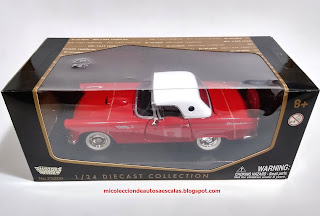El Ford Thunderbird es un automóvil del segmento F fabricado en los Estados Unidos por la Ford Motor Company. El nombre del Ford Thunderbird proviene del folklore nativo estadounidense de Arizona y Nuevo México. Cuenta la mitología que el Thunderbird (Pájaro del trueno) gobernaba en el cielo y era el ayudante divino del hombre. Sus grandes alas batientes, invisibles para los mortales, originaban los vientos y los truenos, dando lugar a las tormentas del desierto que proporcionaban a los indígenas estadounidenses el agua para seguir viviendo en la sequedad en la que les había situado el destino en América del Norte.
La idea era llamar al Thunderbird Fairlane, pero se consideraron muchas otras opciones; por ejemplo, aun cuando Lewis D. Crusoe se inclinó por el nombre alternativo de Savile, fue él quién convocó a un concurso entre los empleados de Ford Motor Company para sugerir un nombre. El ganador recibiría un premio de USD $250. Alden "Gib" Giberson, un estilista nativo del suroeste, sugirió el nombre de "Thunderbird".
La creación de este coche se atribuye a un antiguo ejecutivo de General Motors, Lewis D. Crusoe, un vicepresidente de Ford, George Walker y un diseñador de Ford, Frank Hershey. Entró en la producción para el año 1955 como un modelo de automóvil deportivo de dos plazas, pero, a diferencia del similar Chevrolet Corvette, el Thunderbird nunca fue vendido como un verdadero automóvil deportivo. Ford lo describió como un coche de lujo personal, una descripción que nombró a un nuevo segmento del mercado. En 1958, el Thunderbird adquirió una segunda fila de asientos. Las generaciones posteriores se hicieron cada vez más grandes hasta que en 1977 se presentó una generación de tamaño menor, continuándose esa tendencia de reducción de tamaño en las generaciones de 1980, y otra vez en 1983. Las ventas fueron buenas hasta la década de 1990, cuando los grandes coupés de 2 puertas lo hicieron impopular, la producción cesó después de 1997. En 1999 en el Salón del Automóvil de Detroit se presentó un prototipo que retomó el nombre Thunderbird, este modelo se basó en una interpretación moderna del descapotable de dos plazas original de 1955. En 2002 fue lanzado nuevamente como modelo de 2 plazas, esta vez con un diseño "retro" que recuerda a la primera generación, que estuvo disponible hasta el final del año 2005.











































